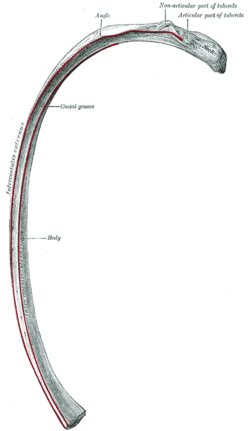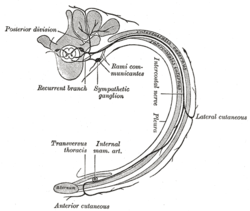Internal intercostal muscles
| Internal intercostal muscles | |
|---|---|
 | |
| Internal intercostal muscles (red) seen from back. | |
 | |
| Deep muscles of the chest and front of the arm, with the boundaries of the axilla (the internal intercostal muscles are labeled as Intercostalis internus at bottom left) | |
| Latin | Musculi intercostales interni |
| Gray's | p.403 |
| Origin | Rib - inferior border |
| Insertion | Rib - superior border |
| Artery | Intercostal arteries |
| Nerve | Intercostal nerves |
| Actions | Hold ribs steady |
| Antagonist | External intercostal muscles |
The internal intercostal muscles (intercostales interni) are a group of skeletal muscles located between the ribs. They are eleven in number on either side. They commence anteriorly at the sternum, in the interspaces between the cartilages of the true ribs, and at the anterior extremities of the cartilages of the false ribs, and extend backward as far as the angles of the ribs, whence they are continued to the vertebral column by thin aponeuroses, the posterior intercostal membranes.
Each arises from the ridge on the inner surface of a rib, as well as from the corresponding costal cartilage, and is inserted into the inferior border of the rib above. The internal intercostals are innervated by the intercostal nerve.[1]
Their fibers are also directed obliquely, but pass in a direction opposite to those of the external intercostal muscles.
For the most part, they are muscles of expiration. In expiration, the interosseous portions of the internal intercostal muscles, (the part of the muscle that is between the bone portion of the superior and inferior ribs), depresses and retracts the ribs, compressing the thoracic cavity and expelling air.[2] The internal intercostals, however, are only used in forceful exhalation such as coughing or during exercise and not in relaxed breathing.[3] The external intercostal muscles, and the intercartilaginous part of the internal intercostal muscles, (the part of the muscle that lies between the cartilage portion of the superior and inferior ribs), are used in inspiration, by aiding in elevating the ribs and expanding the thoracic cavity.[4]
Additional images
-

Position of internal intercostal muscles (red). Animation.
-

Posterior surface of sternum and costal cartilages, showing Transversus thoracis. (Intercostalis internus visible at left.)
-

A central rib of the left side. Inferior aspect.
-

The Obliquus internus abdominis.
-

Diagram of the course and branches of a typical intercostal nerve.
-

Thoracic portion of the sympathetic trunk.
References
- ↑ Seeley's Principles of Anatomy and Physiology by Philip Tate
- ↑ Basic Human Anatomy - O'Rahilly, Müller, Carpenter & Swenson
- ↑ Anatomy and Physiology: The Unity of Form and Function 5th Edition by Kenneth Saladin
- ↑ http://www.yorku.ca/earmstro/journey/internal.html
This article incorporates text from a public domain edition of Gray's Anatomy.
External links
| Wikimedia Commons has media related to Internal intercostal muscles. |
- LUC inin
- -254803891 at GPnotebook
- 18:03-0101 at the SUNY Downstate Medical Center - "The Internal Intercostal Muscle"
- SUNY Figs 18:03-03 - "Transverse section of thorax."
- internal+intercostal+muscle at eMedicine Dictionary
| |||||||||||||||||||||||||||||||||||